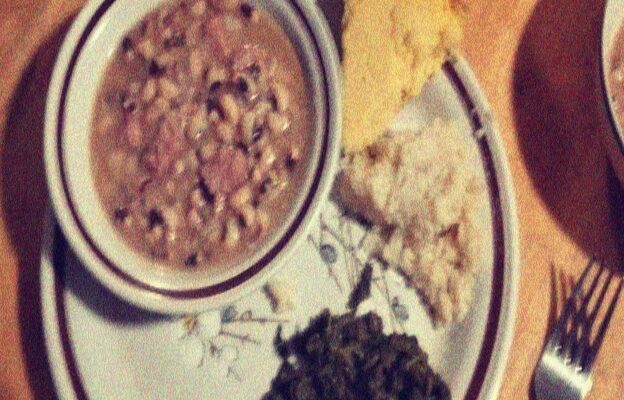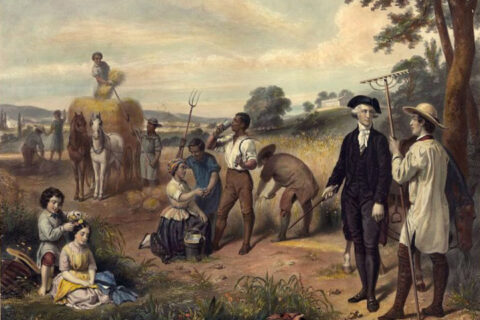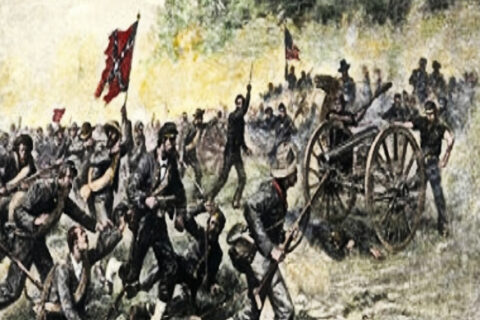(Disclaimer: I realize it will likely seem premature to many of you, dear readers, that I have chosen to write and publish this article weeks in advance of the upcoming event, but there is a method to my “madness” in having done so that you will more fully understand as the event itself comes upon us. Also, I would be remiss if I did not give credit where credit is due to he who was the original inspiration for this article and the several others I have written on the same topic over the last several years. See here.)
QUESTION: Do you know, or have you any idea, of the origins of the Southern tradition of bringing in the New Year with the cooking and serving of black-eyed peas? Some of you perform this act religiously, year-in, year-out, but can you honestly, correctly, and informatively answer the question just posed? If your answer to that question involves “for good luck and prosperity,” or anything of the sort, allow me to ask a follow-up question of you: but why black-eyed peas; what possible connection can black-eyed peas have to good luck and prosperity outside some other connection or connecting influence?
The article you are about to read was written with one overarching goal in mind – namely, that of “weaponizing” you with information concerning the subject at hand, whereby and wherewith you will, from henceforth and for always to the end of your days, be thoroughly equipped and enabled to answer the question I posed to begin this write-up honestly, correctly, and informatively.
Let us begin with an extract from Wikipedia’s entry on Black-eyed peas wherein someone or other has written in part:
Several legends exist as to the origin of this custom. Two popular explanations for the South’s association with peas and good luck dates back to the American Civil War. The first is associated with General William T. Sherman’s march of the Union Army to the sea, during which they pillaged the Confederates’ food supplies. Stories say peas and salted pork were said to have been left untouched, because of the belief that they were animal food unfit for human consumption. Southerners considered themselves lucky to be left with some supplies to help them survive the winter, and black-eyed peas evolved into a representation of good luck.
The only real problem I have with the foregoing paragraph is the author’s use of the word “legend.” Merriam-Webster helpfully informs that a legend is “a story coming down from the past especially: one popularly regarded as historical although not verifiable.”
The key word in that definition is of course, “verifiable.” If a story “popularly regarded as historical” is in fact verifiable, then we’re no longer talking about a “legend,” we’re talking about true fact and true history; true history and fact that is verifiable or provable by a preponderance of the evidence and beyond a reasonable doubt.
The Wikipedia author goes on to provide what (s)he refers to as “challenges” to these stories that would seem to lend credence or justification to his/her insistence on using and repeating the term “legend” to describe them:
One challenge to this legend is that General Sherman brought backup supplies with him including three days of animal feed [11] and would have been unlikely to have left even animal feed untouched. In addition, the dates of the first average frost for Atlanta and Savannah, respectively, are November 13 and November 28.[12] As Sherman’s march was from November 15 to December 21, 1864, it is improbable, although possible, that the Union Army would have come across standing fields of black-eyed peas as relayed in most versions of the legend.
Okay, for those of you who have not read the several articles I have personally written on this very subject over the course of the last three years, let me assure you that I am well-read and well-versed enough on this particular subject and subject matter to know that the “challenges” put forth in that last paragraph, while seemingly plausible at first glance, are laughable at best. Allow me to explain:
First of all, it matters not a whit whether or not “Mother Nature” and General Sherman’s army combined forces to destroy peas of various sorts (black-eyed peas, cow peas, cornfield peas – whatever you prefer to call them) standing in the fields during Sherman’s infamous “March to the Sea” expedition. I say it does not matter a whit because peas of various kinds were the only staple towards the close of the WBTS that the South still had left in abundance. And when I say, “in abundance,” I really mean to say, IN ABUNDANCE! Not in old cornfields still on the vine and yet to be harvested – in storehouses, long since dried and sacked. The Confederate Army had them stockpiled; the Confederate government had them stockpiled; state and city entities had them stockpiled; farmers and plantation owners had them stockpiled; even blacks had an abundance of peas stored in their quarters because blacks had a taste for peas that their white counterparts had never acquired.
Moreover, it is a well-known and well-established fact that the intent of Sherman’s expedition was to leave in his army’s wake “that most reliable of all Generals – General Starvation.” And in accordance with this fiendish strategy, the “order of the day” as regarded food stuffs was for his soldiers to forage what they could for the army’s use, and to shoot every other living animal in their path. There is ample evidence that this is precisely what they did, but the point is that, without farm animals left to feed them to, this “animal food” – the detested cornfield pea – became the “manna sent from Heaven” that ultimately saved a many a non-combatant Southerner the fate General Sherman intended for her.
What the author has done here is not to have issued a legitimate “challenge” to Southern stories associating peas to “good luck” or good fortune in connection with General Sherman’s “March to the Sea” expedition; what (s)he has done is blathered on about a thing (s)he apparently knows little to nothing about, and didn’t bother to learn anything of substance about.
How do I know all of this? I read. Books. Wartime journals and memoirs written by Southern women who actually lived it and wrote about it in dated diary entries as the very events themselves were unfolding. Within the pages of these memoirs are MANY (literally innumerable) references to their surviving on cornfield peas/cow peas, stewed apples and rice, in both direct and indirect connection with General Sherman’s (and Sheridan’s et al) depredations. And as they all agree, the detested cornfield pea was the only food left them that they always had plenty of. Not that General Sherman would not have deprived them of that staple as well had it been within his power to do so. But it wasn’t within his power to do so, and that is the point.
Indeed, there are whole chapters in some of these books/memoirs dedicated to describing How we lived in the last days of the Confederacy. I plucked that title from ch. XXVI of a little book titled, A Virginia Girl in the Civil War, by Myrta Lockett Avary. Speaking of which, two or more years ago I wrote an article for my family on this subject wherein I included the entire contents of the chapter in question due to the fact that there are so many references in it to the sacks of cow peas they had plenty of when there was almost nothing else to eat. I won’t include the entire chapter in this write-up, but here is a relevant excerpt from the same:
We had had a bag of potatoes, but it was nearly empty, there were only a few handfuls of dried apples left—and I must say that even in the face of starvation I was glad of that!—and there was a very small quantity of rice in our larder. We had more peas than anything else.
“Georgia Girl,” Eliza Francis Andrews, also wrote in her wartime memoirs of her family’s larder always containing more peas than anything else:
We eat as little as we can do with ourselves, but we don’t want father’s guests to suspect that we are stinted, so Metta [Eliza’s younger sister] pretends to a loss of appetite, while I profess a great fondness for whatever happens to be most abundant, which is always sure to be cornfield peas, or some other coarse, rank thing that I detest.
Noteworthy in Miss Andrews’s testimony is the fact that her father’s plantation, near Washington, Georgia where their family lived, was outside the limits of General Sherman’s sixty mile-wide line of march, yet her references to living on a diet of cornfield peas in her memoirs in the days and weeks after his infamous march are almost as abundant as the peas were themselves:
Ham and cornfield peas for dinner one day, and cornfield peas and ham the next, is the tedious menu. Mother does her best by making Emily give us every variation on peas that ever was heard of; one day we have pea soup, another, pea croquettes, then baked peas and ham, and so on, through the whole gamut, but alas! they are cornfield peas still, and often not enough of even them.
The reason there was “often not enough even of [peas]” in the Andrews home was because Washington, Georgia became something of a hub at war’s end, through which ragged and hungry Confederate soldiers from places in every compass direction were making their way back to their respective homes, and the Andrews family and other prominent families in Washington hosted and fed many of them. In spite of those facts, they always seemed somehow to find more peas, and precious little else, with which to resupply their larder.
We have no kind of meat in our house but ham and bacon, and have to eat hominy instead of rice, at dinner. Sometimes we get a few vegetables out of the garden, but everything has been so stripped to feed the soldiers, that we never have enough to spread a respectable meal before the large number of guests, expected and unexpected, who sit down to our table every day. In spite of all we can do, there is a look of scantiness about the table that makes people afraid to eat as much as they want – and the dreadful things we have to give them, at that! Cornfield peas have been our staple diet for the last ten days. Mother has them cooked in every variety of style she ever heard of, but they are cornfield peas still. All this would have been horribly mortifying a year or two ago, but everybody knows how it is now, and I am glad to have even cornfield peas to share with the soldiers.
Mary A.H. Gay writes in ch. XXV of her book, Life in Dixie During the War, that:
With the tact peculiar to the refined of every clime and locality, Mrs. Trenholm assumed management of the culinary department, and her dinner-pot hung upon our crane several weeks, and daily sent forth appetizing odors of bacon and peas. How we enjoyed those peas and that bacon, and the soup seasoned with the only condiments at our command—salt and red pepper—and the good hoe cakes!
Mrs. Trenholm had a large sack of cow peas, and a sack of dried fruit, and other articles of food which she had provided for herself and her family before she left Southwest Georgia en route to her home in Marietta, which she left in obedience to the order of William Tecumseh Sherman, and which she learned, before reaching Decatur, had shared the fate of nearly all other homes which had to be thus abandoned.
Although magnanimously proffered, we were averse to sharing Mrs. Trenholm’s well-prepared and ofttimes tempting cuisine, unless our proportion of food equaled hers; and fearing even the appearance of scanty supplies, I set about to gather up “the miners,” so that we might appoint a day to again go lead digging, if that which we left in as many little heaps as there were members of the company had been, in the interim, gathered up by others.
When Mrs. Gay speaks of “miners” and “lead digging” in the quotation above, she is making reference to a little motley crew of children (the “miners”) she would, from time to time, lead to a spot where Sherman’s army had camped weeks before for purposes of foraging lead balls and other valuable items the soldiers had carelessly strewn about and left lying on the ground. And with the alacrity of a cheerful yet shrewd business-woman, Mrs. Gay would promptly march her little motley crew of school-aged foragers to the nearby Confederate commissary where she would offer the booty the “miners” had collected for the day in exchange for its value in … you guessed it – cornfield peas, and rice, and a little salt if they had it to exchange.
One page further on, Mrs. Gay writes:
And good Mrs. Trenholm said her sack of peas was like the cruse of oil that never seemed to diminish in quantity, however much was taken out of it.
Little wonder given that Mrs. Gay was using her industry and that of her foragers to add to Mrs. Trenholm’s inexhaustible sack of peas from time to time. But I should bring this lengthy article to a close:
If I had time to look them all up, I could continue piling testimony on top of testimony, recorded by different Southern women scattered about at different locations across the Southland, all referencing their reliance on the detested, but plentiful, cornfield pea, in the wake of General Sherman’s plunderous “March to the Sea” expedition. But I should imagine that will not be necessary at this point. As is plainly evident from those few authors and their written witness I have quoted, the elements of the “legend” of how and when and why the tradition originated of Southerners preparing and eating black-eyed peas to bring in the New Year, and with it good luck or good fortune, are all there, tucked away in the quotations I have provided you. I put it before you, the jury, that I have proved my case by a preponderance of the evidence and beyond a reasonable doubt; and it is upon the evidence I have above-given that I rest my case.
Tell all your friends and relatives, and in so telling, add for them real meaning and purpose to a tradition they, like myself and many of you, have likely observed their entire lives without a hint of knowledge of the real reasons why. Encourage them to bring in the upcoming New Year with a heaping helping of black-eyed peas and a little ham or bacon added in for flavor, and to honor the blessed memories of their ancestors in the process, remembering well why and how and when, but especially why, this Southern tradition began. You’ll be doing them a personal service, and a service to the broader Southland.
God bless Dixie!







I wonder why they detested peas so much. I like them. Maybe because they were so old and thus harder.
That is a question – and a good one – that I cannot answer satisfactorily, Dave. Like you, I personally like peas; one of our sons – our eldest – likes them even more than me. I think that *maybe* the reason they detested them so much, has something to do with the fact that those who wrote about the situation as it was and as it was happening, were from the “better set” of Southerners. By which I mean that class of persons who were more or less “well to do” in modern lingo.
I have my doubts that lower class Southerners at the time shared the distaste for peas that their higher-class brethren articulated in their “wartime memoirs.” I reckon that “white trash” Southerners likely weren’t nearly as averse to eating peas as their “genteel” upperclassmen were or tended to be. Plus, it is easy to “detest” a thing when there is an abundance of everything else that most find to be more palatable to their tastes.
I’m not sure that some of my own children do not imbibe the lesson of this article more than others of them, simply because some of my children do not like black-eyed peas at all; whereas, others of them, as with my son aforementioned, like them a lot. …
THE REAL MESSAGE … “WE” … GET OUT OF THIS IS WE SHOULD ALWAYS KEEP STOCKED UP ON FOOD AND SUPPLIES IN PREP FOR THE NWO VERSION(S) OF SHERMANS MARCH! IT’S NOT TIME FOR ELOQUENT REMINISCING OF PAST TRADITIONS. NO. IT’S TIME TO SUPPLY UP AND CREATE A BLUEPRINT FOR OUR SURVIVAL.
I thank you, “Josey,” for proving my point about you and your antics in another thread. Some of us simply cannot help ourselves, no? In any case, you will kindly comment on my articles in a way that makes sense. Otherwise, keep your “opinions” to yourself. If not, I will ask the editors to delete your comments forthwith. Understand?
I like peas and have them nearly every New Years day. I am pretty excited to know some specifics about the tradition and I appreciate Mr. Morris digging this deep and sharing this. The main point i took from Josie W.’s comment is the seemingly imminent shortage of foods that is being engineered by the DC and WEF globohomo Satanistas. Dried Black Eyed peas are plentiful now and it would be prudent to stock up on them and other reasonably priced pulses and grains.
I tried some dried insects in South America out of curiosity and have NONE stored. This New Year of 2023 will be a good time to take a lesson from Sherman’s evil and put some peas away for leaner times.
You’re very welcome, sir. As I explained to Tex Wood below, it was the correllation of his 2018 original article on this topic, and my having already read several “wartime journals” of Southron women of the day, that really put me on the right track to documenting the source(s) of this tradition originally.
The (ongoing) issue between Josey W. and me is, as I iterated in a former thread, much more complicated that just that. The all-caps thing (as well as several others) has been a source of contention between us for six or seven months, and counting. Indeed, Josey wrote his comment in this thread in all-caps, purposely thumbing his nose at my criticisms of that tack in other threads more or less recent. But that is something between me and him, and that I would prefer to keep between me and him as much as possible; I only mention its source and its continuation so that you don’t think I’m just “nitpicking” at Josey for the sake of, well, nitpicking at him.
Thank you for the comment; glad you liked the article.
Mr Morris, In researching for that old article back in 2019, “Why Do Southerners Eat Black-Eyed Peas on New Years?” I found that other sympathetic writers on the topic had no historical references. As a consequence, leftist organizations quickly denied the veracity of the story as simply unproven “legend” passed down from generation to generation and little more. Of course, I knew that for the story to move from “legend” to “historical fact” it would need biographical references from Southrons of the time period, each telling the story from their own unique perspective. No previous writers from our heritage were able to assemble those crucial historical references. So deep inside the internet in some obscure blog or message board I found a quote you had made from the diary of Eliza Frances Andrews, 1864-1865 and included it in the beginning of that old article. Since then however, you’ve stayed on top of the issue by finding and organizing multiple biographical references from other diaries and multiple Southrons of the time period on the issue. Mr Morris, you have single-handedly moved this story from “legend” to provable “historical fact” and I’m honored to have taken whatever little part in your inspiration. On behalf of my three beautiful Southron babies and another on the way I say, “thank you”!
Dear Tex:
I wanted to link back to your original (2018) article in my “disclaimer” to head this article, but I quickly learned, in seeking out that original article of yours, that our archives unfortunately do not go back that far. In any case, please keep in mind that, when I first read that 2018 ID article of yours, I had already read Miss Andrews’s Wartime Journal, as well as several others containing these references. What your 2018 article in question did for me as such, was to make me reflect back on all the references in the journals in question I had personally read – to their reliance on cornfield peas in Miss Andrews’s journal, for example, as well as several others I had read. Before I read your wonderful article, in other words, it simply had never occurred to me the connection of our long-standing tradition of preparing and serving black-eyed peas to bring in the New Year, with those abundant references to which I refer. I cannot take credit for that for which you, sir, are most responsible for. God Bless you and your little Southron brood, Tex, Sincerely!
Thank you brother, my family will have a more well versed, and some solemn moments are supper on New Years henceforth.
Whenever I read of the hardships our people endured, I am pressed to continue.
Thank you, sir. I am very gratified that you liked it.